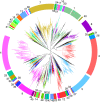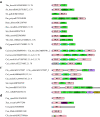Evolution, substrate specificity and subfamily classification of glycoside hydrolase family 5 (GH5)
- PMID: 22992189
- PMCID: PMC3526467
- DOI: 10.1186/1471-2148-12-186
Evolution, substrate specificity and subfamily classification of glycoside hydrolase family 5 (GH5)
Abstract
Background: The large Glycoside Hydrolase family 5 (GH5) groups together a wide range of enzymes acting on β-linked oligo- and polysaccharides, and glycoconjugates from a large spectrum of organisms. The long and complex evolution of this family of enzymes and its broad sequence diversity limits functional prediction. With the objective of improving the differentiation of enzyme specificities in a knowledge-based context, and to obtain new evolutionary insights, we present here a new, robust subfamily classification of family GH5.
Results: About 80% of the current sequences were assigned into 51 subfamilies in a global analysis of all publicly available GH5 sequences and associated biochemical data. Examination of subfamilies with catalytically-active members revealed that one third are monospecific (containing a single enzyme activity), although new functions may be discovered with biochemical characterization in the future. Furthermore, twenty subfamilies presently have no characterization whatsoever and many others have only limited structural and biochemical data. Mapping of functional knowledge onto the GH5 phylogenetic tree revealed that the sequence space of this historical and industrially important family is far from well dispersed, highlighting targets in need of further study. The analysis also uncovered a number of GH5 proteins which have lost their catalytic machinery, indicating evolution towards novel functions.
Conclusion: Overall, the subfamily division of GH5 provides an actively curated resource for large-scale protein sequence annotation for glycogenomics; the subfamily assignments are openly accessible via the Carbohydrate-Active Enzyme database at http://www.cazy.org/GH5.html.
Figures


References
-
- Varki A. Essentials of glycobiology. 2. Cold Spring Harbor, N.Y.: Cold Spring Harbor Laboratory Press; 2009. - PubMed
-
- Lichtenthaler FW. In: Methods and reagents for green chemistry: an introduction. Tundo P, Perosa A, Zecchini F, editor. Hoboken, NJ: J. Wiley; 2007. Carbohydrates as renewable raw materials: a major challenge of green chemistry; pp. 23–63.
-
- Laine RA. A calculation of all possible oligosaccharide isomers both branched and linear yields 1.05x10(12) structures for a reducing hexasaccharide: the isomer barrier to development of single-method saccharide sequencing or synthesis systems. Glycobiology. 1994;4:759–767. doi: 10.1093/glycob/4.6.759. - DOI - PubMed
-
- Sharon N. The conquest of the last frontier of molecular and cell biology. Foreword Biochimie. 2001;83:555–555. doi: 10.1016/S0300-9084(01)01310-4. - DOI
-
- Anonymous. 10 Emerging Technologies That Will Change the World. Technology Review. 2003. pp. 33–51.
Publication types
MeSH terms
Substances
LinkOut - more resources
Full Text Sources
Other Literature Sources
Molecular Biology Databases

